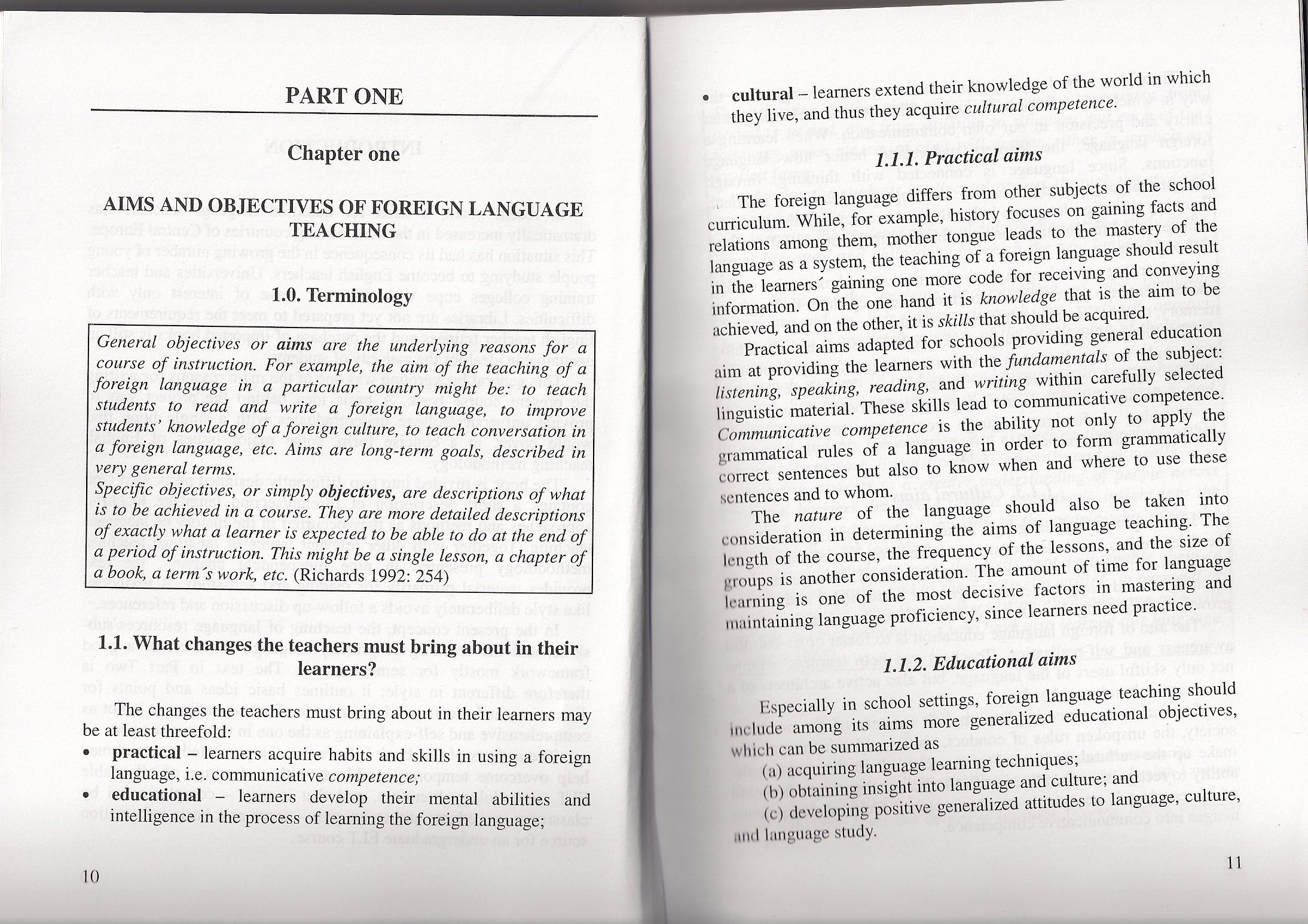skanowanie0005 (107)

PART ONE
Chapter one
AIMS AND OBJECTIVES OF FOREIGN LANGUAGE TEACHING
1.0. Terminology
General objectives or aims are the underlying reasons for a course of instruction. For example, the aim of the teaching of a foreign language in a particular country might be: to teach students to read and write a foreign language, to improve students’ knowledge of a foreign culture, to teach conversation in a foreign language, etc. Aims are long-term goals, described in very generał terms.
Specific objectives, or simply objectivesy are descriptions of what is to be achieved in a course. They are morę detailed descriptions ofemctly what a leamer is expected to be able to do at the end of a period of instruction. This might be a single lesson, a chapter of a book, a term's work, etc. (Richards 1992: 254)
1.1. What changes the teachers must bring about in their learners?
The changes the teachers must bring about in their learners may be at least threefold:
• practical - learners acąuire habits and skills in using a foreign language, i.e. communicative competence;
• educational - learners develop their mental abilities and intelligence in the process of leaming the foreign language;
• cultural - learners extend their knowledge of the world in which
they live, and thus they acąuire cultural competence.
1.1.1. Practical aims
The foreign language differs from other subjects of the school curriculum. While, for example, history focuses on gaining facts and relations among them, mother tongue leads to the mastery of the language as a system, the teaching of a foreign language should result in the learners" gaining one morę codę for receiving and conveying Information. On the one hand it is knowledge that is the aim to be achieved, and on the other, it is skills that should be acąuired.
Practical aims adapted for schools providing generał education aim at providing the learners with the fundamentals of the subject: listening, speaking, reading, and writing within carefułly selected linguistic materiał. These skills lead to communicative competence. Communicative competence is the ability not only to apply the grammatical rules of a language in order to form grammatically correct sentences but also to know when and where to use these sentences and to whom.
The naturę of the language should also be taken into consideration in determining the aims of language teaching. The length of the course, the frequency of the lessons, and the size of groups is another consideration. The amount of time for language Icarning is one of the most decisive factors in mastering and maintaining language proficiency, sińce learners need practice.
1.1.2. Educational aims
Especially in school settings, foreign language teaching should Include among its aims morę generalized educational objectives, which can be summarized as
(a) acquiring language leaming techniques;
(b) obtaining insight into language and culture; and
(c) developing positive generalized attitudes to language, culture, and language study.
11
Wyszukiwarka
Podobne podstrony:
skanowanie0020 (27) Suggestopedia is a method of foreign language teaching developed by the Bulgaria
skanowanie0109 r Grauberg, W. 1997. The Elements of Foreign Language Teaching. Multilingual Matters
Snggpstopedia Suggestopedia is a method of foreign language teaching developed by Bulgarian doctor a
Zdjęcie 0258 U! Please DO NOT WRITE on paoer ui PART ONE In thv* port of Ute e s amination you will
12 6 The last very important parameter is familiarity with the aims and motives. Knowing the aims an
The Natural Ąpproach The natural approacli is a metliod of second language teaching proposed by S. K
INSTITUTE OF ECONOMICS and INSTITUTE OF NURSING (Jagiellońska Str. 61) INSTITUTE OF FOREIGN LANGUAGE
macpherson p 9(1) PART ONE LANGUAGE AND STYLELeft- and Right-Handed Sentences Typical of many types
Easy Tatting (5) Part One—Just Rings One tatting shuttle filled with any size and color thread will
więcej podobnych podstron